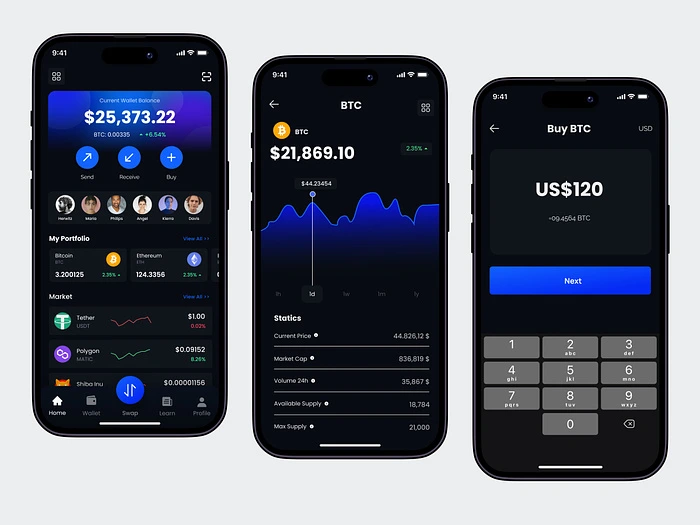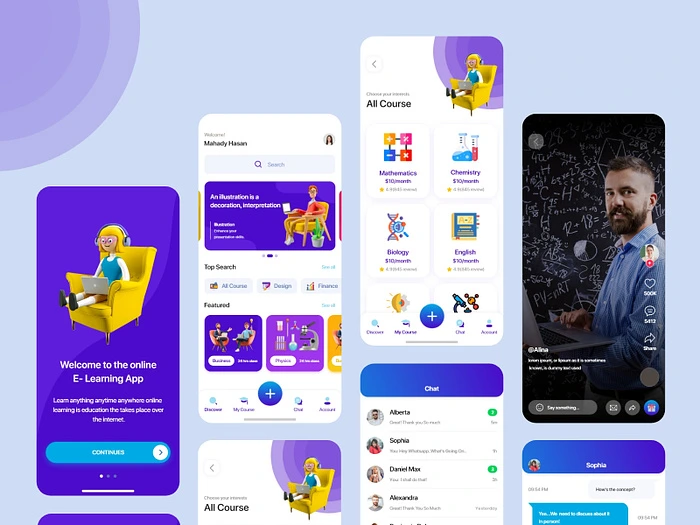Top 15 Software Development Trends for 2025
Software development is a dynamic field, always adapting to new technologies and user needs. As we look ahead to 2025, it’s essential to stay informed about the prominent software development trends that will shape the industry. Lets to explore the top 15 software development trends in 2025 as you’re about to find out the latest technologies in software industry.
1. Emphasis on Cloud
The adoption of cloud computing for businesses has accelerated significantly, offering businesses greater flexibility and scalability. Gartner predicts continued growth in cloud services spending, reflecting the ongoing shift to digital transformation.
These services allow businesses to scale up or down as needed, providing flexibility in uncertain times. According to Gartner, worldwide end-user spending on public cloud services is projected to grow by 18.4% in 2021. As businesses continue to digitalize their operations, this is one of the software development trends that is likely to persist into 2024 and beyond.
2. Growing Use of Blockchain

Blockchain development extends beyond cryptocurrency, providing a secure and transparent way to record transactions. Its applications span various industries, from supply chain management to finance, enhancing tracking in logistics and more.. According to Statista, the blockchain market is expected to reach $39.7 billion by 2025, indicating a growing demand for this technology.
3. Evolution of AI
As artificial intelligence is transforming the world and machine learning development continue to advance, technologies are enabling innovative solutions across various domains. The rapid advancements in AI bring forth a wave of opportunities driven by new software technologies. Natural Language Processing (NLP), which enables computers to understand and interpret human language, is a particularly promising area of AI. According to a report by Stanford University, AI patenting has grown by 34% annually since 2000. Additionally, there is growing interest in ethical AI, which aims to ensure AI systems behave in a way that is ethical and beneficial to humanity.
4. A Surge in Low-Code/No-Code Development
Low-Code/No-Code (LCNC) programming has emerged as a crucial trend in software development process. It enables non-technical users to create applications, helping to alleviate the shortage of software engineers. According to Gartner, LCNC development is projected to increase by 23% in 2021. This software development trend is expected to continue in 2025, further democratizing software development.
5. The Ascendancy of React, Go, Kotlin, JavaScript, Swift And TypeScript
Modern programming languages like React, Go, Kotlin, JavaScript, Swift, and TypeScript are becoming increasingly popular. They offer features like type inference, null safety, and expressiveness that can make software development services or process more efficient and enjoyable.
JavaScript and TypeScript, in particular, continue to dominate the web development landscape. According to Stack Overflow’s 2021 Developer Survey, JavaScript is the most commonly used programming language, while TypeScript is rapidly gaining popularity.
Python’s ascendancy also continues unabated, largely due to its simplicity and versatility. It’s widely used in data analysis, machine learning, web development, and automation.
React, a JavaScript library for building user interfaces, has become the go-to choice for many developers due to its flexibility, efficiency, and robust ecosystem.
Go and Kotlin, although newer, are also gaining traction. Go, developed by Google, is prized for its simplicity and efficiency. Kotlin, on the other hand, is fully interoperable with Java and is the preferred language for Android app development.
Swift, the successor to Objective-C, has become the standard for iOS app development due to its performance and safety features.
6. Progress in Use of Modern Languages
Emerging languages like Rust, Go, and Kotlin are attracting developers with their modern features and capabilities, reflecting a significant programming trend in 2025. Rust, for example, is gaining attention for its focus on performance, reliability, and productivity. It was named the “most loved” language in GitHub’s 2020 Report, indicating a potentially bright future in software engineering.
7. Uptick in Native App Development
With the proliferation of mobile devices, native app development is more important than ever. Native apps offer a superior user experience in software development compared to hybrid apps, as they are designed specifically for the platform they’re on. Statista reports that mobile ad spending is expected to surpass $240 billion by 2022, further reinforcing the importance of mobile apps.
8. Rise in Progressive Web Apps
Progressive Web Apps (PWAs) are hybrid applications that combine the best of web and mobile apps. They are accessible via web browsers but offer functionality traditionally associated with native apps, such as offline access andpush notifications. Google has been a major proponent of PWAs, suggesting that they along with progressive web application development companies will likely continue to grow in popularity.
9. Emphasis on Cybersecurity
With the increase in cyber threats and data breaches, cybersecurity will remain a top concern for companies. Implementing robust security measures, staying up-to-date with the latest threats, and training employees on secure practices are critical steps to ensure data protection. The global cybersecurity market (including cybersecurity services) size is expected to grow to $345.4 billion by 2026, reflecting why is cybersecurity important.
10. Internet Of Behavior (IoB) For Personalization
The Internet of Behavior (IoB) is one of the emerging software development trends that extends the Internet of Things (IoT) by not only gathering data from devices but also tracking and analyzing people’s behaviors as they interact with apps and devices. Although IoB has yet to gain mainstream traction, Gartner predicted that 40% of the worldwide population will have their behaviors tracked by 2023.
The data gathered via IoB can be used to create a more personalized user experience. Startups can look at how platforms like YouTube and Facebook use IoB to provide personalized content and advertisements based on users’ behaviors and preferences. As personalization becomes increasingly important in the digital experience, the use of IoB is likely to grow.
11. Total Experience For Improved Conversion

Customer experience is pivotal in today’s software development and software development trends. Forbes reports that 96% of customers cite experience as a key factor in establishing brand loyalty. This leads us to the concept of Total Experience (TX) in app development.
TX amalgamates different aspects of a business – customer experience, user experience, employee experience, and multi-experience – into a central point of intersection. With a TX approach, startups can provide an optimal experience for their customers while also empowering their support teams.
The essence of TX lies in unified communication, which necessitates the integration of effective customer support technologies. It’s crucial to ensure seamless communication between customers and support personnel, even when the latter are working remotely.
Virtual Private Network (VPN) providers that offer round-the-clock, responsive live-chat support exemplify the concept of total experience. Their approach underscores the importance of having a support team that can respond promptly and effectively, thereby enhancing the overall user experience and contributing to customer satisfaction and loyalty.
12. Edge Computing
Edge computing processes data closer to where it’s created (the “edge” of the network), reducing latency and bandwidth use. According to Grand View Research, the global edge computing market size was valued at USD 3.5 billion in 2019 and is expected to grow at a compound annual growth rate (CAGR) of 37.4% from 2020 to 2027. This is particularly important for IoT devices, which generate huge amounts of data. Edge computing can also improve privacy and security by keeping data local.
13. Augmented Reality and Virtual Reality
Augmented Reality (AR) and Virtual Reality (VR) are rapidly emerging as powerful tools for businesses and consumers alike. These technologies are changing the way we interact with digital environments, creating immersive experiences that can be used for everything from gaming to training.
According to Statista, the global market size for AR and VR is expected to reach $72.8 billion by 2024, indicating a growing interest in these technologies. As the technology improves and becomes more accessible, the use of AR and VR is expected to grow.
Some of the key software development trends driving the growth of AR and VR include:
- Improved hardware: Advances in hardware, such as the development of more powerful smartphones and headsets, are making AR and VR more accessible and affordable.
- Increased adoption: Businesses are increasingly adopting AR and VR to improve customer engagement, enhance training, and streamline operations.
- Innovative applications: Developers are creating a wide range of innovative AR and VR applications, from educational tools to virtual shopping experiences.
14. Microservices Architecture
Microservices architecture breaks down applications into small, independent services that communicate with each other. This makes it easier to update or scale parts of an application without affecting the whole system. According to Market Research Future, the global microservices architecture market is expected to reach USD ~$33 Billion by 2023 at a CAGR of ~17%. Companies like Netflix and Amazon have successfully used this architecture, leading to more businesses adopting it.
Some of the key software development trends driving the adoption of microservices architecture include:
- Cloud adoption: Microservices architecture is well-suited for cloud-native applications, as it allows for easy scaling and deployment of services on cloud platforms.
- DevOps: Microservices architecture aligns well with DevOps practices, enabling faster development, testing, and deployment cycles.
- Containerization: Containers, such as Docker, provide a lightweight and portable way to package and deploy microservices, simplifying management and deployment.
15. DevOps Adoption
DevOps – a set of practices that combines software development and IT operations – aims to shorten the development cycle and provide continuous delivery of high-quality software. According to a report by Statista, the global DevOps market size is expected to reach $12.85 billion by 2025, showing an increasing software development trend towards this software development methodology. As businesses seek to increase efficiency and improve collaboration between development and operations teams, implementing Devops is expected to rise.
Is Outsourcing Software Development A Good Idea?
Yes, outsourcing software development can be a beneficial approach for many businesses. Here's why:
- Cost Efficiency: Outsourcing can often be more cost-effective than maintaining an in-house team, particularly for small to medium-sized businesses or startups.
- Access to Expertise: You can get access to a large pool of talented developers and specialists who are up-to-date with the latest technologies and trends.
- Flexibility: Outsourcing allows for scaling your team size up or down based on project requirements, without the long-term commitments of hiring full-time staff.
- Focus on Core Business: Outsourcing technical tasks allows your in-house team to focus on the core business aspects.
How Much Does Software Development Cost?
The cost of IT outsourcing can vary significantly based on the scope of work, the expertise required, and the pricing model adopted. Two common pricing models include team-based pricing and fixed-cost pricing. Regarding IT outsourcing models and project estimation:
- Dedicated Team Model: A long-term partnership where the outsourcing company provides a dedicated team to work exclusively on your projects. This model is beneficial for large projects with evolving requirements.
- Fixed Price Model: The project scope and timeline are well-defined, and the outsourcing company delivers the project for a fixed price. This model is suitable for small-to-midsize projects with clear specifications.
- Time and Material Model: This model provides the greatest flexibility, as you pay for actual work hours spent on the project. This model is ideal for projects where requirements may change frequently.
Project estimation in outsourcing involves determining the time and resources required for the project. It includes assessing the project size, complexity, and potential risks. Accurate project estimation is crucial for setting realistic deadlines and budgets.
Common Factors Affecting The Costs Of Software Development
The software's scale significantly influences its development cost, whether produced in-house or outsourced. The scale varies based on the needs of an organization and its user base.
- Small Scale: This involves crafting straightforward software with minimal custom coding requirements.
- Mid Scale: This pertains to the development of Minimum Viable Products (MVPs) featuring a singular functionality in its simplest form.
- Large Scale: This entails the creation of comprehensive software, featuring a myriad of functionalities, API integrations, and database components.
- Enterprise Scale: This refers to the generation of internal or customer-facing applications designed for enterprises servicing tens of thousands of users, with a focus on delivering an outstanding user experience.
What Are The 07 Steps Of Software Development Life Cycles?
Partner with Savvycom to elevate and streamline each phase of your SDLC:
- Planning: Savvycom strategizes with you, defining clear objectives aligned with your vision.
- Analysis: Our team conducts thorough requirements analysis, ensuring feasibility and optimal solutions.
- Design: Savvycom's expert designers create intuitive and aesthetically pleasing software structures.
- Development: Our developers, proficient in the latest technologies, construct robust software.
- Testing: Savvycom's rigorous testing processes verify functionality and identify potential issues.
- Implementation: We ensure smooth deployment of your software, minimizing disruption.
- Maintenance: Savvycom provides regular updates and troubleshooting, ensuring your software remains efficient and effective.
Why Software Development Is Important?
Software development plays a pivotal role in the success of modern businesses and organizations, offering a multitude of benefits. Here are some key reasons why software development is crucial:
- Increased Efficiency
- Improved User Experience
- Enhanced Security
- Cost Savings
- Streamlined Collaboration
- Data Collection & Analysis
- Increased Mobility & Accessibility
- Scalability & Flexibility of Solutions
Does Savvycom Provide Dedicated Development Team?
A dedicated development team is a model where an outsourcing company provides a team that works exclusively on your project. They act as an extension of your in-house team. Benefits of this model include:
- Focus: The team is entirely dedicated to your project.
- Flexibility: It's easier to manage changes in project requirements.
- Cost Efficiency: You get a full team without the overhead of hiring in-house.
Looking for a top-notch dedicated development team? Savvycom offers excellent value, providing high-quality dedicated development teams at attractive prices.
Nearshore And Offshore Development At Savvycom
Offshore Software Development is when you outsource work to a company in a different country, usually one with a significantly different time zone. Benefits include:
- Cost Efficiency: Lower operational and labor costs.
- Access to Global Talent: Bigger pool of skilled developers.
Nearshore Software Development is outsourcing to a company in a nearby country, often in the same or a similar time zone. Benefits include:
- Cultural Similarity & Time Zone: Easier collaboration and communication.
- Quality Work at Competitive Prices: High value for investment.
Savvycom, with robust capabilities and a global presence, is the perfect partner to scale your business, both nearshore and offshore. Get in touch today to kickstart your journey to success.
From Tech Consulting, Mobile App Development Services, Web App Development Services to #1 Vietnam outsourcing software service! Since 2009, Savvycom has been harnessing digital technologies for the benefit of businesses, mid and large enterprises, and startups across the variety of industries. Savvycom dedicated software development team can help you to build high-quality custom software development services and products as well as deliver a wide range of related professional services.
Savvycom is right where you need. Contact us now for further consultation:
- Phone: +84 24 3202 9222
- Hotline: +1 408 663 8600 (US); +612 8006 1349 (AUS); +84 32 675 2886 (VN)
- Email: [email protected]


